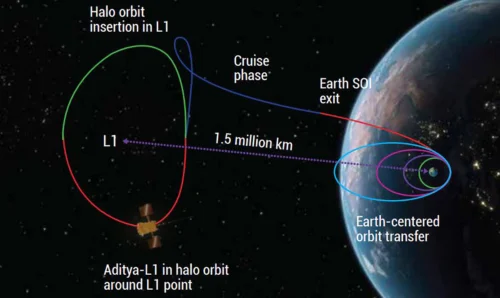Rama Krishna Sangem
Aditya L1, the Indian Space Research Organisation’s (ISRO) maiden solar mission, successfully entered its final manoeuvre to reach its destination and injected into its final orbit on January 6, Saturday, as per schedule..
The Indian Space Research Oganisation (ISRO) launched the Aditya L1 solar observatory in September 2023.(CESSI / IISER-Kolkata) The Indian Space Research Oganisation (ISRO) launched the Aditya L1 solar observatory in September 2023.(CESSI / IISER-Kolkata) ISRO chief S Somanath told news agency ANI on Monday “Aditya-L1 is going to reach its L1 point on January 6 at 4pm and we are going to do the final manoeuvre to keep it there.”
Launched on September 2 last year, the spacecraft has undergone four earth-bound manoeuvres and a Trans-Lagrangean Point 1 Insertion (TL1I) manoeuvres, all successfully.
The mission aims to observe the Sun’s corona and understand its extreme heat from a halo orbit around the first Sun-Earth Lagrangian point (L1), which is located roughly 1.5 million km from the Earth.
Lagrange Point is between Earth and Sun gravity
The Lagrange Point is a unique region where gravitational forces between the Earth and the Sun reach equilibrium. While absolute neutralization is not achievable due to the influence of other celestial bodies such as the Moon, Mars, and Venus, the L1 point provides a stable position for observational purposes.
There is a solar exclusion zone which is about 5 degrees. So we placed our satellite in Halo orbit. This halo orbit is perpendicular to the line of sight towards the sun. So in moving in that orbit, our satellite is always looking at the sun. So 24 hours a day and all the days of the year, it is going to observe the Sun. For ISRO reaching L1 and placing a satellite in an orbit around it is remarkable. It’s for the first time. The second thing is, for all Indian institutions that have payloads on Aditya L1…”: Space Scientist & Astronomer RC Kapoor.
Prime Minister Narendra Modi hailed this space achievement of ISRO as a landmark for India.



